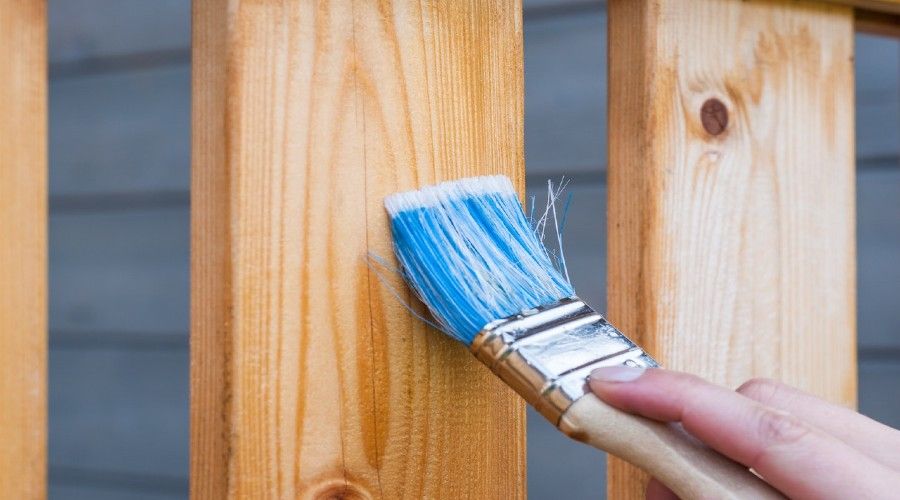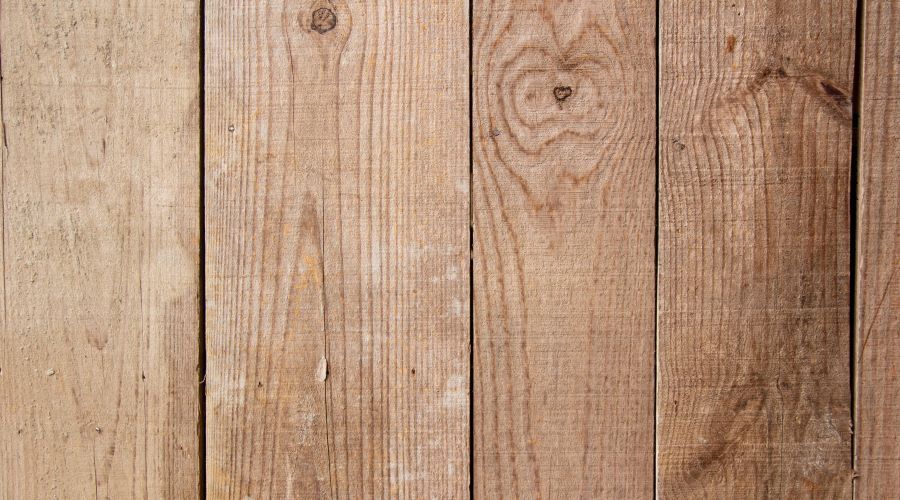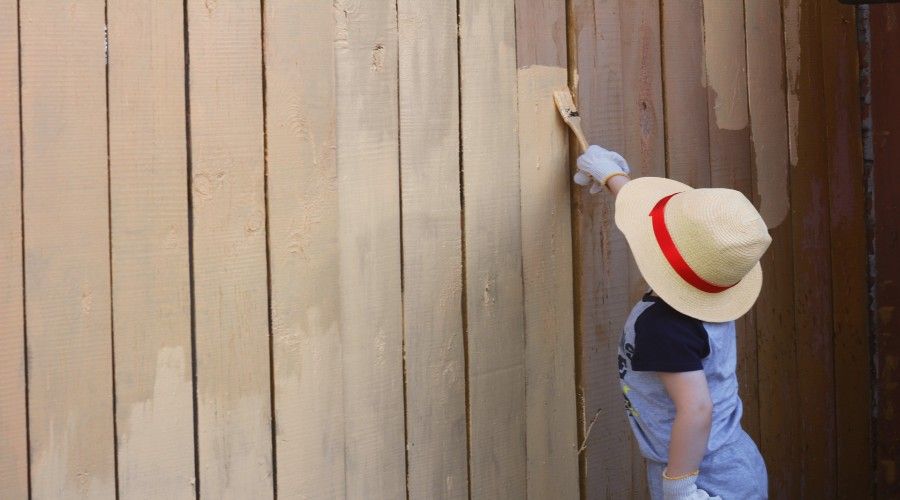Whether you’re constructing a new fence, or considering your options to bring your existing wooden fence back to life, choosing the right fence stain can feel overwhelming. There are so many different options, it can be difficult to weed out the best fence stain for your own unique situation.
The key to choosing the right stain for your fence is to dig into the details. Your choice will be influenced by the type of wood that you’re staining, the elements that you’re most concerned about, and the overall look that you want to create. Below, we’re going to discuss our top five picks including which situation each is best suited for.
The Backyard Boss Top Fence Stain for 2021
|
PRODUCT |
FEATURES |
||
|---|---|---|---|
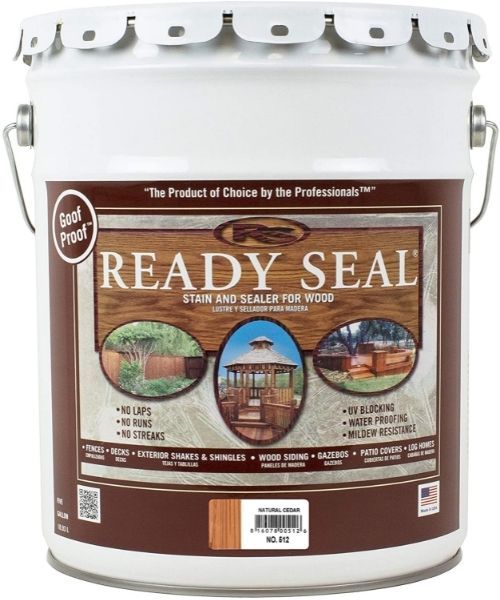
|
|
||
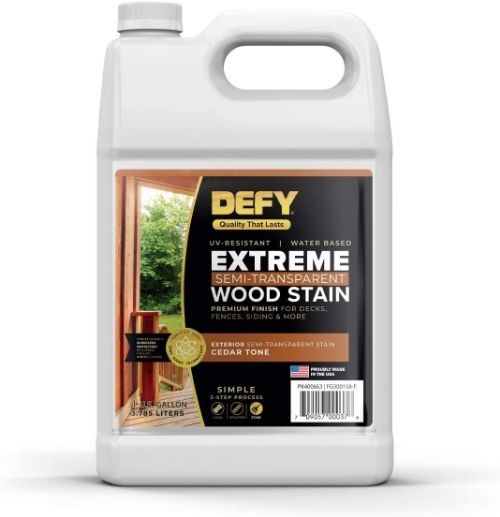
|
|
||
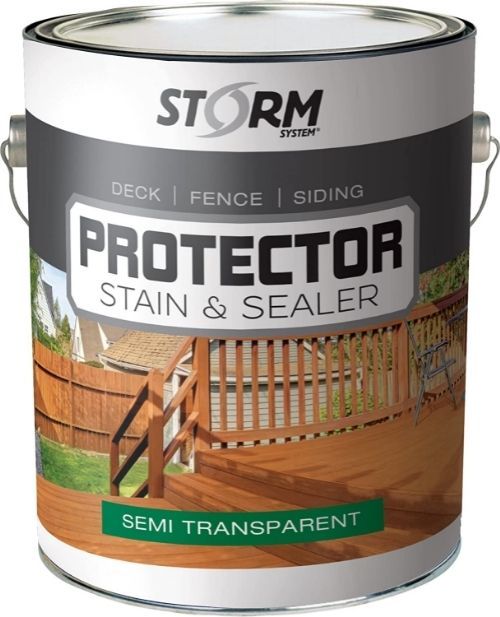
|
|
||
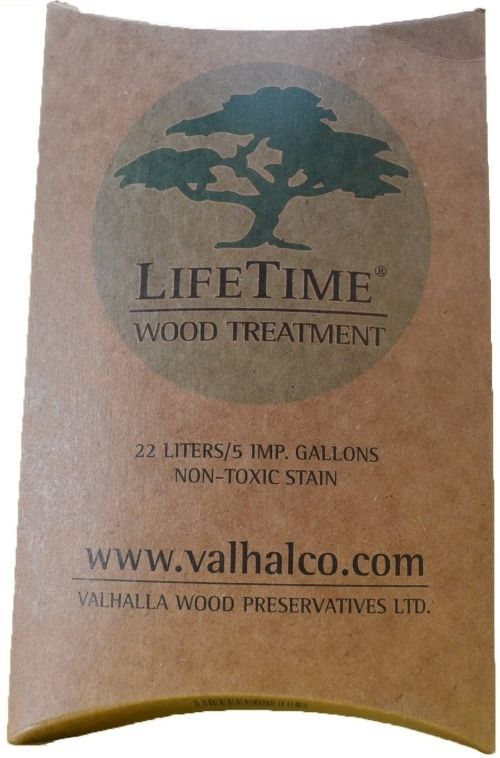
|
|
||
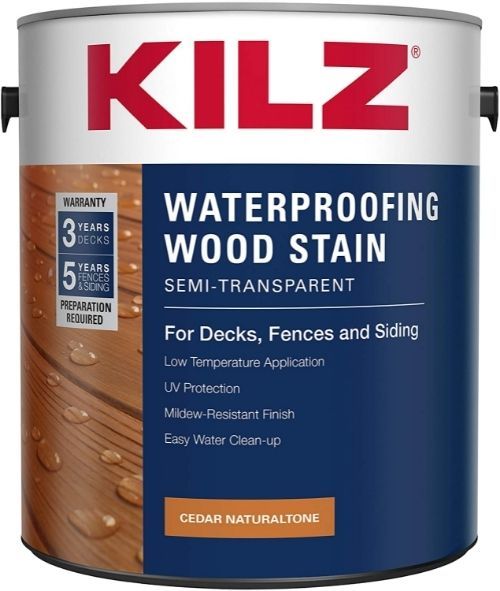
|
|
Why You Can Trust Us
Here at Backyard Boss, we’re a team of outdoor lovers and passionate DIYers. We enjoy spending our time making the most of our backyard and deck spaces, including the work that goes into building the outdoor space of our dreams. For many, including me, that means building the perfect fence to frame out our yards and keep our families safe.
Having gone through the process of researching and experimenting through my own backyard projects, I had the opportunity to discover what works and what was, quite honestly, a waste of my time and money. With that in mind, I’ve taken my research and experience and used it to put together this guide, to help you make the best decision for your own backyard DIY projects.
Best Oil-Based Stain
A professional-grade wood stain and sealer that can be applied using any method to create a smooth, streak-free finish.
- Can be applied in any temperature
- No runs, streaks, or laps
- Biodegradable product
- Doesn’t reach its true color until approximately 14 days after application
|
|
Why We Like It: This professional-quality, oil-based stain is easy to apply with your choice of tools, requiring no primer or wet-line application. This means that you don’t need to waste your time prepping your fence, to get the result that you desire. The stain comes in 8 different colors, including light oak, pecan, dark walnut, mission brown, burnt hickory, mahogany, redwood, and natural cedar. The formula includes sealant, making it a great option to protect your wooden fence from UV rays, moisture damage, mold, and algae.
While this is an oil-based stain, the fact that it’s a biodegradable product means that it doesn’t carry many of the chemical-related concerns associated with other oil-based products. This means that you can enjoy the extra protection of an oil-based stain, while still prioritizing the eco-friendliness of your project. The stain has a 48 to 72 hour curing time and takes approximately 14 days to settle into its true color.
Who Should Buy It: If you’re looking for a highly durable oil-based stain, without worrying about the environmental impact of the high VOC content in most formulas, this is a great choice.
Best Water-Based Stain
An environmentally friendly water-based stain that allows the natural wood grain of your fence to shine through while protecting it from damaging UV rays and color loss.
- Fortified with Zinc Nano-Particle Technology
- High quality resins are fade resistant
- Low-VOC (Volatile Organic Compound)
- Higher-priced
- Only offers 6 colors
|
|
Why We Like It: This water-based stain is environmentally friendly, offering incredible protection for your fence with the fortified zinc nano-particle technology. Like sunscreen for your fence, this technology protects the wood against damaging UV rays without unnecessary chemicals. The resins in the DEFY Extreme Semi-Transparent Wood Stain are resistant to both fading and darkening.
This semi-transparent stain is designed to highlight the natural wood grain in your fence, with a variety of natural color options, including driftwood gray, redwood, natural pine, light walnut, cedar, and butternut. It’s a little bit pricier than many of the other options on this list, but it's ultra-durable and will protect your wood fence for years.
Who Should Buy It: DEFY Extreme Semi-Transparent Wood Stain is a great option for those that are looking for a high-quality stain to protect their fence, without too many chemicals.
Best For New Wood
An oil-based stain that works to not only protect against moisture and UV damage, but to highlight the natural wood grains in your fence.
- Easy to apply with any tool or process
- Compatible with almost all types of wood
- Higher VOC content
- Only available in 6 colors
|
|
Why We Like It: If you’ve recently put up a new fence, taking steps to protect the wood is a top priority. An oil-based stain that is compatible with nearly all types of wood, the Storm System Protector Stain & Sealer, is a great option for both first-time DIYers and experienced backyard lovers alike. It can be applied easily using a spray application, brush, or roller. Once dry, it works to repel moisture and protect your wooden fence from mold, mildew, and rot.
The color availability is limited, with only 6 shades. However, the semi-transparent formula works to bring out the natural grain, in both hardwoods and softwoods. Color options include black/walnut, cedartone, golden oak, hickory, pacific redwood, and sienna. A traditional oil-based stain has a higher VOC content, which means that it’s not the most eco-friendly choice. You should avoid using it in direct contact with garden soils.
Who Should Buy It: A great solution for newer DIYers, the Storm System Protector Stain & Sealer is an easy-to-apply stain that will effectively protect newer wood from the elements.
Best Sustainable Option
This eco-friendly, non-toxic wood treatment works by permanently modifying the structure of your wood while creating no harmful residue.
- Can be used in direct contact with garden soils
- Does not fade or wear
- Powder formula, only mix what you need
- No control over color, brings out the natural silver, aged patina of the wood
- Must mix product before use
|
|
Why We Like It: A wood preservative uses naturally occurring mineral and plant substances, to modify the structure of the wood permanently. This not only changes the color and appearance of the wood but also works to protect the wood over time. While other stains will wear and fade, the protective treatment process of the Valhalla Wood Preservatives Lifetime Wood Treatment is enhanced with exposure to the elements. If you enjoy a more natural look, this process brings out an unaffected, aged silver patina effect.
The real benefit of this product is how environmentally friendly it is. While many wood stains contain harmful chemicals, this wood treatment is completely non-toxic. It creates no harmful residue, meaning that it’s even safe to use when in direct contact with the soil of your garden.
Who Should Buy It: If you’re looking for a safe, non-toxic treatment for your fence, this is a great option to consider.
Best Budget Stain
Offering protection against the elements for up to 5 years, this low-cost and reliable wood stain is backed by a well-known brand.
- Low-cost
- Protects against mold, moisture, rot and UV-rays
- Limited color options available
- Takes up to 72 hours to fully cure
|
|
Why We Like It: The process of staining your wooden fence can quickly add up. KILZ Waterproofing Wood Stain is a great low-cost option to protect your fence from rain, snow, mildew, and UV rays. This is a semi-transparent, water-based stain, meaning that it’ll show off the natural wood grains of your fence and it’s easy to clean up when you’re finished. It can be used on new wood or moderately weathered wood (0 to 10 years of exposure) that has been prepared for staining. After application, it takes approximately 24 hours to dry and up to 72 hours before it fully cures.
Being water-based, it’s also more eco-friendly than the chemical-filled alternatives. It’s backed by a well-known, and trusted brand name, as well as warrantied for up to 5 years on fences. The color options for this stain are limited, including only cedar and redwood.
Who Should Buy It: Home DIY lovers that are looking to stain their garden or backyard fence on a budget should consider the KILZ Waterproofing Wood Stain.
What Should You Stain Your Fence With
If you’re considering staining (or re-staining) a yard or garden fence, you may be wondering how to choose the right stain color and product. Unlike painting, where the paint sits on the wood’s surface, choosing a stain is a slightly more challenging decision. The stain soaks into each plank of wood on your fence, staining it the color of your choice. If you’re unhappy with the result, you can’t sand it off and start again, without compromising the fence itself.
Wood Surface Type
Image Credit: Franco Antonio Giovanella on Unsplash
The first consideration when choosing the best stain for your fence is to consider the type of wood surface that you’re working with. This will influence the best type of stain to use, the number of coats needed, and the amount of prep work that will be required.
Softwood Fences
Softwood fences, like pine and cedar, have a high absorption rate. This makes it difficult to stain them with a water-based stain, as it absorbs the stain too quickly to evenly spread it across the fence. The result is uneven and blotchy. Instead, use an oil-based stain to allow you the time needed to apply the stain evenly.
Hardwood Fences
Hardwood fences vary, creating a spectrum ranging from being able to absorb most stain types, to being difficult to stain at all. This variation depends on the size of the pores in the wood. Oak and ash are the easiest to stain, working with most stains on the market. Maple, alder, and birch all have smaller pores, making it more difficult to absorb the stain. A water-based stain is absorbed easier, increasing your chances of creating an even appearance.
Finally, the hardwoods with the smallest pores are the most challenging to stain, as they don’t absorb the stain easily at all. This includes cherry, mahogany, and walnut. To stain fences made from these materials, you need to do some preparation work, including sanding the surface. They also tend to change color more with aging. To prevent this, fences made from these materials should be sealed.
Water-Based vs Oil-Based
The best way to determine whether to use a water-based, or oil-based stain, is to look at the type of wood that you’re staining, as mentioned above. However, if you’re staining an oak fence, where most stains will work, how do you choose between the two?
Water-based stains offer a more environmentally friendly option, with mold and mildew resistant options. They also don’t give off the fumes that come from using an oil-based stain, meaning that you can do the work without worrying about a headache. Unfortunately, they offer less UV protection. Alternatively, oil-based stains are more durable and tend to last longer than water-based options.
Oil-based stains generally contain more chemicals than water-based alternatives. Studies have shown that these chemicals can have serious health implications if they aren’t used properly. For this reason, oil-based stains should always be used with plenty of ventilation. If you’re spraying on your stain, or are otherwise concerned about the chemicals, a mask or respirator can be used for additional protection.
Stain Opacity
The stain opacity refers to how transparent the stain will be when it goes onto the wood. This will range from highly transparent stains that allow you to see the original grain of the wood easily, all the way up to solid stains that create a layer on top of the wood like paint, completely hiding the grain of the wood.
To decide on the best stain opacity, you need to consider your desired result. Solid stains completely mask the grain of the wood, but they offer the best UV protection. A step down from this is semi-solid stains, which still offer a significant amount of coverage and UV protection.
Solid stains completely cover the wood by creating a film-like paint. They offer the best UV protection, however, they completely hide the grain and are vulnerable to chipping. Semi-solid stains still hide nearly all the wood grain but offer a slightly more natural look. Semi-transparent stains are transparent enough to allow some of the wood grain detail of your fence to be visible. Finally, transparent stains are clear, offering no UV protection, and are most often used as a sealant for water protection.
One important factor to consider is that the UV protection levels decrease as the transparency increases. While a semi-solid stain still offers a relatively high level of UV protection, that protection is significantly lower with a semi-transparent stain.
Image Credit: atner from Pixabay
Sealant
Sealant works to protect your fence from moisture damage. Some stains will include sealant in their formula, allowing for a one-step process with complete protection. However, if the stain that you choose doesn’t include sealant, you can apply it on top of an already stained fence, as an additional protective layer to seal water out.
Staining Tools and Accessories
In addition to choosing the right stain, you also need to ensure that you have all the necessary tools and accessories to complete your job properly. This list can vary slightly depending on the scope of your work, and the obstacles that you may be facing throughout the process.
You will need a supply of plastic drop cloths and painter’s tape to protect the area around your fence, including garden spaces, rose bushes, lawn ornaments, and brick walkways. If you aren’t sure whether something may be in the ‘line of fire’, err on the side of caution. Taking a couple of extra minutes to cover these items now can save you the frustration of items stained, possibly with no opportunity to repair or salvage them.
The other thing that you need to consider saving is yourself. Always wear gloves when working with stains. You also want to choose old clothing or clothing that you aren’t concerned about being damaged. Make sure that you have plenty of rags on hand.
The tools needed for the actual process of staining the fence will include a quality stiff bristle brush, paint roller, paint tray, paint can opener, and stir stick. Depending on the product and application that you choose, you may also need a paint sprayer and all the accompanying supplies. However, if your job can be done with a brush and roller, this allows you to focus on the finer details.
Which Fence Stain Lasts the Longest?
The type of stain best known for its durability over time is a solid, oil-based stain (assuming that the wood you’re staining is suitable for an oil-based stain). However, it should be noted that these stains will completely conceal the grain of the wood. If you’re concerned about seeing the wood grain on your fence for a more natural appearance, a semi-solid stain offers slightly less protection but allows you to maintain some of the grain in the final look.
Is It Better to Stain or Seal a Fence?
Neither of these options offers a better solution than the other if used separately. A stain can be purchased with a high UV protection level, but it will still be susceptible to moisture damage without the sealant. On the other hand, the sealant does a great job of keeping water out but offers no UV protection.
If you’re looking for a solution that will protect your fence from all the elements, including damaging UV rays and water damage, your best option would be to choose a stain that includes sealant or to apply sealant after you finish staining.
How We Picked
To choose the best fence stain options for a variety of situations, we first had to look at the individual factors that can influence that choice. This includes creating a list of stains that are best suited for hardwood, softwood, environmental concerns, and more. Each of the stains that made this list were stand-out products that were high-quality and reliable.
We then cut this list down, by looking at several important factors, including durability of the stain, expected lifespan before re-staining is required, durability, versatility, and availability of colors. In addition to looking at the product details and our own experiences, we also read through a variety of customer reviews to learn more about how these products worked in real-life situations. With all of this in mind, we were able to identify five products that are well worth considering for your backyard DIY projects.
The Best Fence Stain for Your Backyard Fence Is...
Choosing the best fence stain for your next project is easier than it may seem at first glance. After narrowing down your choices based on the type of wood that you are staining, you can look at the unique features that will work to create the final result that you’ve envisioned. For example, are you looking for a more natural wood look, or would you like a bright, bold color to stand out in your yard? I hope that this guide helps you to consider your needs specifically.
Our top pick for the best fence stain is the Ready Seal Stain and Sealer for Wood. By creating a biodegradable, oil-based stain, this product allows you to leverage all the durability and reliability that comes with using an oil-based formula, without worrying about the harsh chemicals. This means that it’s both a practical and environmentally-friendly choice.

